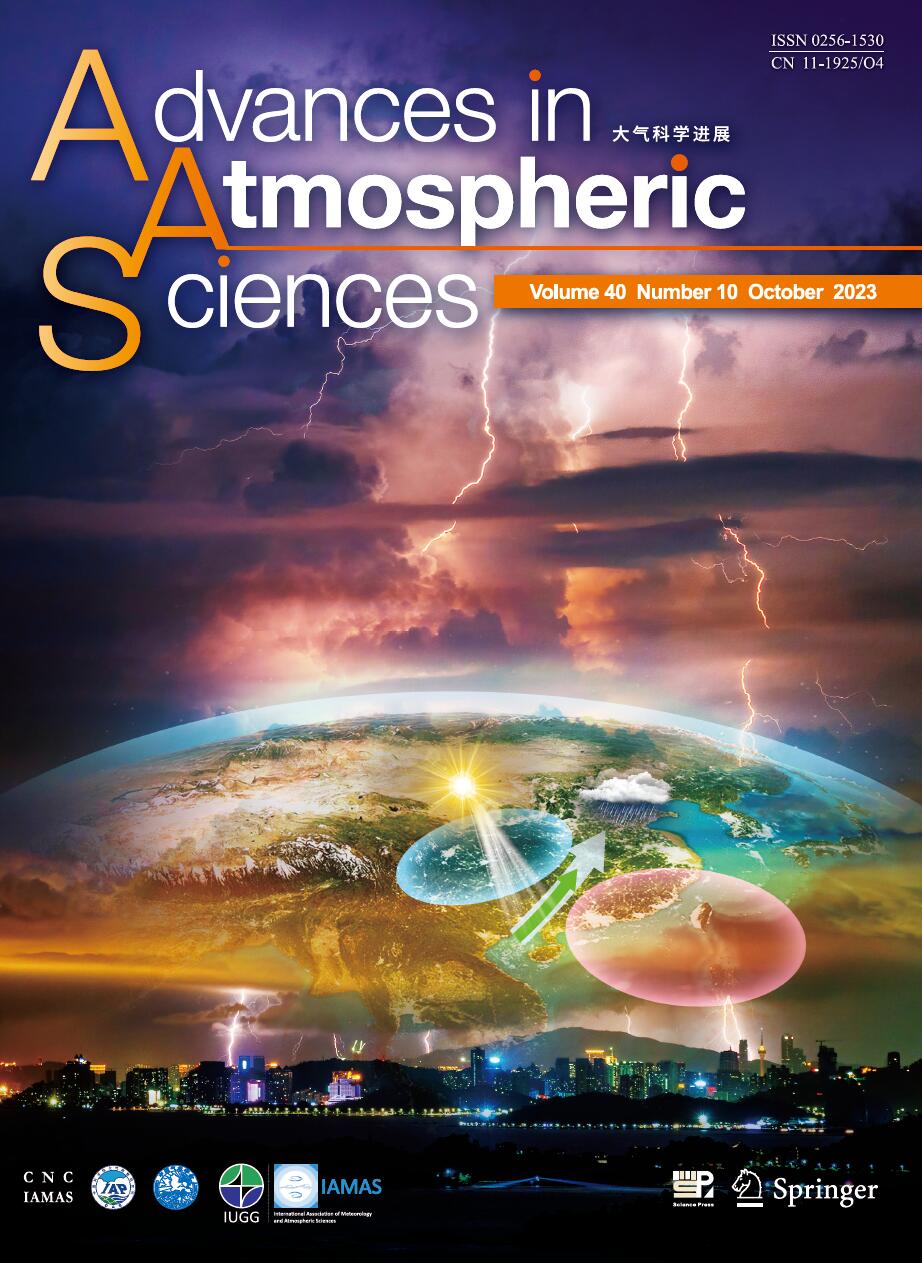| [1] |
LI Tao, ZHENG Xiaogu, DAI Yongjiu, YANG Chi, CHEN Zhuoqi, ZHANG Shupeng, WU Guocan, WANG Zhonglei, HUANG Chengcheng, SHEN Yan, LIAO Rongwei,
2014: Mapping Near-surface Air Temperature, Pressure, Relative Humidity and Wind Speed over Mainland China with High Spatiotemporal Resolution, ADVANCES IN ATMOSPHERIC SCIENCES, 31, 1127-1135.
doi: 10.1007/s00376-014-3190-8
|
| [2] |
XIE Zhenghui, SU Fengge, LIANG Xu, ZENG Qingcun, HAO Zhenchun, GUO Yufu,
2003: Applications of a Surface Runoff Model with Horton and Dunne Runoff for VIC, ADVANCES IN ATMOSPHERIC SCIENCES, 20, 165-172.
doi: 10.1007/s00376-003-0001-z
|
| [3] |
Jianguo LIU, Zong-Liang YANG, Binghao JIA, Longhuan WANG, Ping WANG, Zhenghui XIE, Chunxiang SHI,
2023: Elucidating Dominant Factors Affecting Land Surface Hydrological Simulations of the Community Land Model over China, ADVANCES IN ATMOSPHERIC SCIENCES, 40, 235-250.
doi: 10.1007/s00376-022-2091-5
|
| [4] |
LI Hongqi, GUO Weidong, SUN Guodong, ZHANG Yaocun, FU Congbin,
2011: A New Approach for Parameter Optimization in Land Surface Model, ADVANCES IN ATMOSPHERIC SCIENCES, 28, 1056-1066.
doi: 10.1007/s00376-010-0050-z
|
| [5] |
LI Fang, ZENG Xiaodong, SONG Xiang, TIAN Dongxiao, SHAO Pu, ZHANG Dongling,
2011: Impact of Spin-up Forcing on Vegetation States Simulated by a Dynamic Global Vegetation Model Coupled with a Land Surface Model, ADVANCES IN ATMOSPHERIC SCIENCES, 28, 775-788.
doi: 10.1007/s00376-010-0009-0
|
| [6] |
LIANG Miaoling, XIE Zhenghui,
2008: Improving the Vegetation Dynamic Simulation in a Land Surface Model by Using a Statistical-dynamic Canopy Interception Scheme, ADVANCES IN ATMOSPHERIC SCIENCES, 25, 610-618.
doi: 10.1007/s00376-008-0610-7
|
| [7] |
CHEN Feng, XIE Zhenghui,
2011: Effects of Crop Growth and Development on Land Surface Fluxes, ADVANCES IN ATMOSPHERIC SCIENCES, 28, 927-944.
doi: 10.1007/s00376-010-0105-1
|
| [8] |
Dai Yongjiu, Zeng Qingcun,
1997: A Land Surface Model (IAP94) for Climate Studies Part I: Formulation and Validation in Off-line Experiments, ADVANCES IN ATMOSPHERIC SCIENCES, 14, 433-460.
doi: 10.1007/s00376-997-0063-4
|
| [9] |
Dai Yongjiu, Xue Feng, Zeng Qingcun,
1998: A Land Surface Model (IAP94) for Climate Studies Part II: Implementation and Preliminary Results of Coupled Model with IAP GCM, ADVANCES IN ATMOSPHERIC SCIENCES, 15, 47-62.
doi: 10.1007/s00376-998-0017-5
|
| [10] |
Fuqiang YANG, Li DAN, Jing PENG, Xiujing YANG, Yueyue LI, Dongdong GAO,
2019: Subdaily to Seasonal Change of Surface Energy and Water Flux of the Haihe River Basin in China: Noah and Noah-MP Assessment, ADVANCES IN ATMOSPHERIC SCIENCES, 36, 79-92.
doi: 10.1007/s00376-018-8035-4
|
| [11] |
Zhang Yu, Lu Shihua,
2002: Development and Validation of a Simple Frozen Soil Parameterization Scheme Used for Climate Model, ADVANCES IN ATMOSPHERIC SCIENCES, 19, 513-527.
doi: 10.1007/s00376-002-0083-z
|
| [12] |
ZHANG Shuwen, LI Deqin, QIU Chongjian,
2011: A Multimodel Ensemble-based Kalman Filter for the Retrieval of Soil Moisture Profiles, ADVANCES IN ATMOSPHERIC SCIENCES, 28, 195-206.
doi: 10.1007/s00376-010-9200-6
|
| [13] |
Jinliang Liu, Han-Ru Cho,
2001: Effects of Topographic Slopes on Hydrological Proecsses and Climate, ADVANCES IN ATMOSPHERIC SCIENCES, 18, 733-741.
|
| [14] |
Enda ZHU, Xing YUAN,
2021: Global Freshwater Storage Capability across Time Scales in the GRACE Satellite Era, ADVANCES IN ATMOSPHERIC SCIENCES, 38, 905-917.
doi: 10.1007/s00376-021-0222-z
|
| [15] |
Binghao JIA, Longhuan WANG, Yan WANG, Ruichao LI, Xin LUO, Jinbo XIE, Zhenghui XIE, Si CHEN, Peihua QIN, Lijuan LI, Kangjun CHEN,
2021: CAS-LSM Datasets for the CMIP6 Land Surface Snow and Soil Moisture Model Intercomparison Project, ADVANCES IN ATMOSPHERIC SCIENCES, 38, 862-874.
doi: 10.1007/s00376-021-0293-x
|
| [16] |
DAN Li, JI Jinjun, LIU Huizhi,
2008: Use of a Land Surface Model to Evaluate the Observed Soil Moisture of Grassland at the Tongyu Reference Site, ADVANCES IN ATMOSPHERIC SCIENCES, 25, 1073-1084.
doi: 10.1007/s00376-008-1073-6
|
| [17] |
Runkua Yang, J. Shukla, P.J. Sellers,
1994: The Influence of Changes in Vegetation Type on the Surface Energy Budget, ADVANCES IN ATMOSPHERIC SCIENCES, 11, 139-161.
doi: 10.1007/BF02666542
|
| [18] |
ZHANG Xiaohui, GAO Zhiqiu, WEI Dongping,
2012: The Sensitivity of Ground Surface Temperature Prediction to Soil Thermal Properties Using the Simple Biosphere Model (SiB2)}, ADVANCES IN ATMOSPHERIC SCIENCES, 29, 623-634.
doi: 10.1007/s00376-011-1162-9
|
| [19] |
WANG Zhifu, QIAN Yongfu,
2009: The Relationship of Land-Ocean Thermal Anomaly Difference with Mei-yu and South China Sea Summer Monsoon, ADVANCES IN ATMOSPHERIC SCIENCES, 26, 169-179.
doi: 10.1007/s00376-009-0169-y
|
| [20] |
GUAN Xiaodan, HUANG Jianping, GUO Ni, BI Jianrong, WANG Guoyin,
2009: Variability of Soil Moisture and Its Relationship with Surface Albedo and Soil Thermal Parameters over the Loess Plateau, ADVANCES IN ATMOSPHERIC SCIENCES, 26, 692-700.
doi: 10.1007/s00376-009-8198-0
|















 AAS Website
AAS Website 
 AAS WeChat
AAS WeChat 
 DownLoad:
DownLoad: